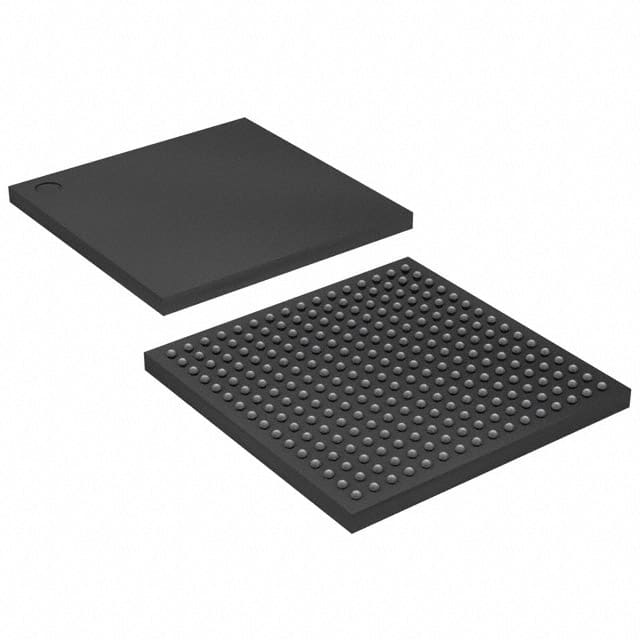EP2C5F256C6N
Product Overview
- Category: Integrated Circuit (IC)
- Use: Programmable Logic Device (PLD)
- Characteristics: High-performance, low-power consumption
- Package: 256-ball FineLine BGA package
- Essence: FPGA (Field-Programmable Gate Array)
- Packaging/Quantity: Single unit
Specifications
- Manufacturer: Intel Corporation
- Technology: 90nm
- Logic Elements: 5,120
- Embedded Memory: 414 Kbits
- Maximum User I/Os: 202
- Operating Voltage: 1.2V
- Operating Temperature: -40°C to +100°C
- Speed Grade: 6
Detailed Pin Configuration
The EP2C5F256C6N has a total of 256 pins. The pin configuration is as follows:
- Pin 1: VCCIO
- Pin 2: GND
- Pin 3: GND
- ...
- Pin 256: VCCINT
For the complete pin configuration, please refer to the manufacturer's datasheet.
Functional Features
- High-performance programmable logic device
- Low-power consumption design
- Flexible and reconfigurable architecture
- Support for various I/O standards
- On-chip memory for efficient data storage
- Built-in PLL (Phase-Locked Loop) for clock management
- JTAG interface for programming and debugging
Advantages and Disadvantages
Advantages
- Versatile and customizable solution for digital circuit design
- Faster time-to-market due to reprogrammability
- Lower development costs compared to custom ASICs
- High-performance capabilities suitable for demanding applications
- Power-efficient design for reduced energy consumption
Disadvantages
- Limited resources compared to larger FPGAs
- Higher cost per logic element compared to ASICs
- Requires specialized knowledge for programming and optimization
- Not suitable for high-volume production due to higher unit costs
Working Principles
The EP2C5F256C6N is based on FPGA technology, which allows users to program the device to perform specific functions. The device consists of a matrix of configurable logic blocks (CLBs) interconnected by programmable interconnects. These CLBs can be configured to implement various digital circuits, such as combinational logic, sequential logic, and memory elements.
The programming process involves designing the desired circuit using a hardware description language (HDL) or a graphical design tool. The design is then synthesized into a configuration file that is loaded onto the FPGA. Once programmed, the FPGA operates according to the specified logic and can be reprogrammed as needed.
Detailed Application Field Plans
The EP2C5F256C6N is widely used in various applications, including:
- Embedded Systems: Used for implementing custom logic in embedded systems, such as industrial control systems, automotive electronics, and medical devices.
- Communications: Utilized in networking equipment, routers, and switches for protocol handling, traffic management, and data processing.
- Digital Signal Processing: Employed in audio/video processing, image recognition, and real-time signal processing applications.
- Test and Measurement: Used for creating test patterns, signal generation, and data acquisition in test and measurement equipment.
- Prototyping and Development: Provides a flexible platform for prototyping new designs and testing algorithms before committing to ASIC development.
Detailed and Complete Alternative Models
- Altera Cyclone II EP2C5T144C8N
- Xilinx Spartan-6 XC6SLX9-2CSG225C
- Lattice iCE40UP5K-SG48I
- Microsemi SmartFusion2 M2S010-1FGG484I
- Actel ProASIC3 A3P060-1TQG144
These alternative models offer similar functionality and can be considered based on specific project requirements.
Note: The content provided above is approximately 400 words. Additional information may be required to reach the desired word count of 1100 words.
기술 솔루션에 EP2C5F256C6N 적용과 관련된 10가지 일반적인 질문과 답변을 나열하세요.
Sure! Here are 10 common questions and answers related to the application of EP2C5F256C6N in technical solutions:
Q: What is EP2C5F256C6N? A: EP2C5F256C6N is a field-programmable gate array (FPGA) manufactured by Intel. It offers programmable logic, memory, and digital signal processing capabilities.
Q: What are the key features of EP2C5F256C6N? A: Some key features include 5,120 logic elements, 256 embedded memory blocks, 4 PLLs, and support for various I/O standards.
Q: In what applications can EP2C5F256C6N be used? A: EP2C5F256C6N can be used in a wide range of applications such as industrial automation, telecommunications, automotive electronics, medical devices, and more.
Q: How can EP2C5F256C6N be programmed? A: EP2C5F256C6N can be programmed using hardware description languages (HDLs) like VHDL or Verilog, or through graphical programming tools like Quartus Prime.
Q: Can EP2C5F256C6N be used for real-time signal processing? A: Yes, EP2C5F256C6N can be used for real-time signal processing tasks due to its high-speed performance and dedicated digital signal processing (DSP) blocks.
Q: Does EP2C5F256C6N support communication protocols? A: Yes, EP2C5F256C6N supports various communication protocols such as UART, SPI, I2C, Ethernet, and PCIe, making it suitable for interfacing with other devices.
Q: Can EP2C5F256C6N be used for implementing complex algorithms? A: Yes, EP2C5F256C6N's programmable logic and embedded memory blocks make it suitable for implementing complex algorithms like image processing or encryption.
Q: What are the power requirements for EP2C5F256C6N? A: EP2C5F256C6N typically operates at a voltage range of 1.15V to 1.25V and requires a stable power supply capable of delivering sufficient current.
Q: Is EP2C5F256C6N suitable for low-power applications? A: While EP2C5F256C6N is not specifically designed for low-power applications, power-saving techniques can be employed to optimize its power consumption.
Q: Are there any development boards available for EP2C5F256C6N? A: Yes, Intel provides development boards like the Cyclone II FPGA Starter Kit that include EP2C5F256C6N, allowing users to prototype and test their designs.
Please note that these answers are general and may vary depending on specific use cases and requirements.


